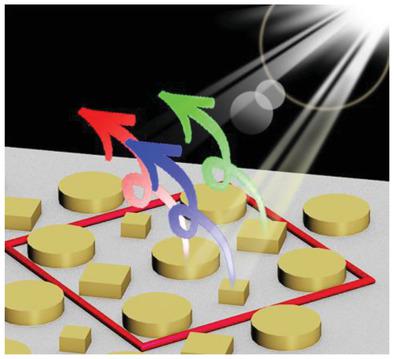当前位置:
X-MOL 学术
›
Adv. Funct. Mater.
›
论文详情
Our official English website, www.x-mol.net, welcomes your feedback! (Note: you will need to create a separate account there.)
Programmable Multiple Plasmonic Resonances of Nanoparticle Superlattice for Enhancing Photoelectrochemical Activity
Advanced Functional Materials ( IF 19.0 ) Pub Date : 2020-09-16 , DOI: 10.1002/adfm.202005170 Rui Xu 1 , Liaoyong Wen 2 , Zhijie Wang 3, 4 , Huaping Zhao 1 , Guannan Mu 1 , Zhiqiang Zeng 1 , Min Zhou 1 , Sebastian Bohm 1 , Huanming Zhang 1 , Yuhan Wu 1 , Erich Runge 1 , Yong Lei 1
Advanced Functional Materials ( IF 19.0 ) Pub Date : 2020-09-16 , DOI: 10.1002/adfm.202005170 Rui Xu 1 , Liaoyong Wen 2 , Zhijie Wang 3, 4 , Huaping Zhao 1 , Guannan Mu 1 , Zhiqiang Zeng 1 , Min Zhou 1 , Sebastian Bohm 1 , Huanming Zhang 1 , Yuhan Wu 1 , Erich Runge 1 , Yong Lei 1
Affiliation

|
Building nanoparticle (NP) superlattices formed in a complex fashion by subsets that can be explored separately presents a promising approach to realize the next generation of superlattices for different applications. Here, by incorporating self‐aligned and geometrically different subsets of Au NPs into one matrix with the assistance of multi‐pore anodic alumina oxide templates, scaled‐up NP superlattices are constructed with programmable multiple plasmonic resonances. The inter‐peak spectral distance is tailored in a broad wavelength range from less than 50 nm up to about 1000 nm through altering not only the size and height of each subset, but also the number and nature of the NP subset. Importantly, a mechanical oscillator model is developed to elucidate the microscopic origin of the spectral programmability and to reproduce the parameter dependence of the multiple plasmonic resonances. A photoelectrochemical cell using Au NP superlattice embedded photoanodes is investigated as a proof‐of‐concept, demonstrating a high photoresponse improvement of about 260% compared to that of bare film reference. In light of the compatibility of this technique with other plasmonic materials and the geometrical tunability, these findings enable systematic optical controlling toward optical devices with multimodal plasmonics.
中文翻译:

纳米粒子超晶格的可编程多重等离子体共振,以增强光电化学活性
建立可以通过单独探索的子集以复杂方式形成的纳米粒子(NP)超晶格,为实现针对不同应用的下一代超晶格提供了一种有前途的方法。在这里,通过在多孔阳极氧化铝模板的帮助下,将自对准且几何上不同的Au NPs子集合并到一个矩阵中,按比例放大的NP超晶格可以通过可编程的多个等离子体共振来构建。通过不仅改变每个子集的大小和高度,而且改变NP子集的数量和性质,可以在从小于50 nm到大约1000 nm的宽波长范围内定制峰间光谱距离。重要的,开发了机械振荡器模型以阐明光谱可编程性的微观起源,并重现了多个等离子体共振的参数依赖性。对使用Au Au NP超晶格嵌入的光阳极的光电化学电池进行了概念验证,证明与裸膜参比相比,光响应提高了约260%。考虑到该技术与其他等离子体材料的兼容性和几何可调性,这些发现使得能够对具有多峰等离子体的光学设备进行系统的光学控制。与裸胶膜参比样品相比,光响应提高了约260%。考虑到该技术与其他等离子体材料的兼容性和几何可调性,这些发现使得能够对具有多峰等离子体的光学设备进行系统的光学控制。与裸胶膜参比样品相比,光响应提高了约260%。考虑到该技术与其他等离子体材料的兼容性和几何可调性,这些发现使得能够对具有多峰等离子体的光学设备进行系统的光学控制。
更新日期:2020-11-25
中文翻译:

纳米粒子超晶格的可编程多重等离子体共振,以增强光电化学活性
建立可以通过单独探索的子集以复杂方式形成的纳米粒子(NP)超晶格,为实现针对不同应用的下一代超晶格提供了一种有前途的方法。在这里,通过在多孔阳极氧化铝模板的帮助下,将自对准且几何上不同的Au NPs子集合并到一个矩阵中,按比例放大的NP超晶格可以通过可编程的多个等离子体共振来构建。通过不仅改变每个子集的大小和高度,而且改变NP子集的数量和性质,可以在从小于50 nm到大约1000 nm的宽波长范围内定制峰间光谱距离。重要的,开发了机械振荡器模型以阐明光谱可编程性的微观起源,并重现了多个等离子体共振的参数依赖性。对使用Au Au NP超晶格嵌入的光阳极的光电化学电池进行了概念验证,证明与裸膜参比相比,光响应提高了约260%。考虑到该技术与其他等离子体材料的兼容性和几何可调性,这些发现使得能够对具有多峰等离子体的光学设备进行系统的光学控制。与裸胶膜参比样品相比,光响应提高了约260%。考虑到该技术与其他等离子体材料的兼容性和几何可调性,这些发现使得能够对具有多峰等离子体的光学设备进行系统的光学控制。与裸胶膜参比样品相比,光响应提高了约260%。考虑到该技术与其他等离子体材料的兼容性和几何可调性,这些发现使得能够对具有多峰等离子体的光学设备进行系统的光学控制。



























 京公网安备 11010802027423号
京公网安备 11010802027423号